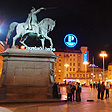ZAGREB CATHEDRAL
A Cardinal’s Repose
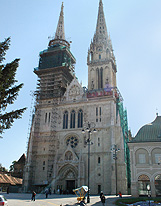 It
is perhaps the most recognized building in Croatia, and its spires
the tallest sight in old Zagreb. The Zagreb Cathedral, dedicated to
St Stephen
and St Ladislas and the Ascention of the Virgin Mary is located near
the Market Square where the colorful shades of the famous farmers
market of Zagreb
gathers. Though now standing alone, the Kapitol was once a complex of
Bishops residence and churches in medieval Zagreb. The first cathedral
on the spot
was begun in 1093 and consecrated in 1217 but destroyed by invading Mongol
Tartars only 25 years later in 1242. It was rebuilt in the early Gothic
age. Under threat from the Turks, defensive walls and towers where
built around
the cathedral and Kapitol complex in 1512. A section of the medieval
defense walls and towers still remain, with the Prislin Tower between
the cathedral
and the present Kapitol Elementary School, one of the best-preserved.
It
is perhaps the most recognized building in Croatia, and its spires
the tallest sight in old Zagreb. The Zagreb Cathedral, dedicated to
St Stephen
and St Ladislas and the Ascention of the Virgin Mary is located near
the Market Square where the colorful shades of the famous farmers
market of Zagreb
gathers. Though now standing alone, the Kapitol was once a complex of
Bishops residence and churches in medieval Zagreb. The first cathedral
on the spot
was begun in 1093 and consecrated in 1217 but destroyed by invading Mongol
Tartars only 25 years later in 1242. It was rebuilt in the early Gothic
age. Under threat from the Turks, defensive walls and towers where
built around
the cathedral and Kapitol complex in 1512. A section of the medieval
defense walls and towers still remain, with the Prislin Tower between
the cathedral
and the present Kapitol Elementary School, one of the best-preserved.
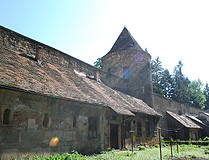 The Turks never made it Zagreb (see Osijek
Fortress on the Drava) but the cathedral couldn’t
survive an earthquake in 1880 which collapsed the nave and one of the
bell towers. A major restoration was undertaken by German born architect
Hermann
Bollé, following the original outlines of the church. Much of
what is seen today is the Neo-Gothic restoration. Bolle also designed
central
building of Zagreb’s Mirogoj Cemetery, where he’s buried.
The two spires of the cathedral reach 354 ft, the tallest in Croatia
stone structures
in Croatia, but the outside of the cathedral of Zagreb is not as remarkable
as what lies inside.
The Turks never made it Zagreb (see Osijek
Fortress on the Drava) but the cathedral couldn’t
survive an earthquake in 1880 which collapsed the nave and one of the
bell towers. A major restoration was undertaken by German born architect
Hermann
Bollé, following the original outlines of the church. Much of
what is seen today is the Neo-Gothic restoration. Bolle also designed
central
building of Zagreb’s Mirogoj Cemetery, where he’s buried.
The two spires of the cathedral reach 354 ft, the tallest in Croatia
stone structures
in Croatia, but the outside of the cathedral of Zagreb is not as remarkable
as what lies inside.
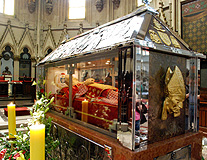 In
the Cathedral of Zagreb behind the altar in a place of reverant repose
inside a glass enclosed temperature and air controlled box lies the preserved
body of the Cardinal Archbishop Aloysius Stepinac, not yet a saint,
but beatified by Pope John Paul II in 1998, and visited by pilgrims.
Stepenic was
Archbishop of Zagreb from 1937 to 1960. A polorizing figure of the socialist
era, under the Nazi occupation during World War II he helped Jews to
escape Croatia
and following
the war was critical of the Yugoslav government under Tito (see Tito’s
Birthhouse), named Cardinal in 1952 by Pope
Pius XII. Cardinal Stepenic was tried by Yugoslav authorities for war
crimes
in what was regarded by
the west as a show trial and ultimately died while under
In
the Cathedral of Zagreb behind the altar in a place of reverant repose
inside a glass enclosed temperature and air controlled box lies the preserved
body of the Cardinal Archbishop Aloysius Stepinac, not yet a saint,
but beatified by Pope John Paul II in 1998, and visited by pilgrims.
Stepenic was
Archbishop of Zagreb from 1937 to 1960. A polorizing figure of the socialist
era, under the Nazi occupation during World War II he helped Jews to
escape Croatia
and following
the war was critical of the Yugoslav government under Tito (see Tito’s
Birthhouse), named Cardinal in 1952 by Pope
Pius XII. Cardinal Stepenic was tried by Yugoslav authorities for war
crimes
in what was regarded by
the west as a show trial and ultimately died while under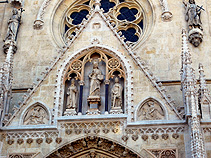 house
arrest in 1960. The circumstances of his death are controversial. Despite
long health
problems, the church believed he was poisoned and declared a martyr.
In the Nebojan
Tower in front of the cathedral is a exhibition of objects, documents
and photographs dedicated to his memory. The cathedral is also the burial
place
for other Croatian national figures Petar Zrinski, Ivan Antun Zrinski
and, Fran Krsto Frankopan as well as two other archbishops Franjo Šeper
and Franjo Kuharic. Pope Benedict recently made a stop at the cathedral
on his journey through Croatia. The Zagreb Cathedral is free to visit with regular services held as Zagreb’s
principal Catholic Church. © Bargain
Travel Europe
house
arrest in 1960. The circumstances of his death are controversial. Despite
long health
problems, the church believed he was poisoned and declared a martyr.
In the Nebojan
Tower in front of the cathedral is a exhibition of objects, documents
and photographs dedicated to his memory. The cathedral is also the burial
place
for other Croatian national figures Petar Zrinski, Ivan Antun Zrinski
and, Fran Krsto Frankopan as well as two other archbishops Franjo Šeper
and Franjo Kuharic. Pope Benedict recently made a stop at the cathedral
on his journey through Croatia. The Zagreb Cathedral is free to visit with regular services held as Zagreb’s
principal Catholic Church. © Bargain
Travel Europe
Find best hotel and travel deals in Croatia on TripAdvisor
Web
Info
Zagreb Tourism
These articles are copyrighted and the sole property of Bargain Travel Europe and WLPV, LLC. and may not be copied or reprinted without permission.
SEE ALSO:
LUZNICA
CASTLE – CONVENT ACCOMMODATIONS
TRAKOSCAN
CASTLE - ZAGORJE

